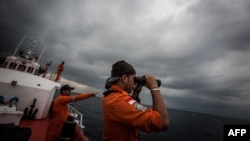China said on Tuesday that none of the Chinese passengers aboard the missing Malaysia Airlines airliner appear to have links to terrorism, as the massive, multinational search for the jet expanded further.
Huang Huikang, China's ambassador to Malaysia, said Tuesday the determination was made following background checks on all 154 of the plane's passengers from the mainland.
"China has conducted a thorough investigation on the background [of Chinese passengers aboard]. So far, [China] has not found any actions that jeopardized Malaysia Airlines MH 370 flight. So we can rule out the possibilities of Chinese passengers suspected of being involved in any kind of terror or jeopardizing activities," said Huikang.
The ambassador also said China has begun looking for the Boeing 777 "in the territory along the northern corridor" of the search area.
The plane appears to have flown either north toward Central Asia or south, deeper into the vast Indian Ocean after it mysteriously vanished on March 8. Investigators believe the jet may have been deliberately diverted from its initial flight path from Kuala Lumpur to Beijing.
The New York Times is reporting the plane's intended route appears to have been altered by a computer system mostly likely programmed by someone in the cockpit with knowledge of advanced aircraft systems.
Speaking anonymously, U.S. officials told the Times the development reinforces the theory that foul play is involved and will likely increase scrutiny of the plane's pilot and co-pilot.
The search has been complicated because the plane's transponder, which identifies it to civilian radar, and other communications devices were disabled or shut off. Authorities are now forced to rely on imprecise satellite tracking data based on automated messages from the aircraft.
Twenty-six countries are involved in the search, which now includes water and land in 11 countries and spans tens of millions of square kilometers.
The search area is now so extensive that the U.S. on Monday called back the USS Kidd, a naval destroyer that had been looking for the plane in the Indian Ocean. U.S. officials say it makes more sense to look for the jet using long-range surveillance aircraft.
Also on Monday, a United Nations spokesman said neither an explosion nor a plane crash on land or on water has been detected so far by the Comprehensive Test Ban Treaty Organization.
The organization records seismic shocks and sound waves around the world to detect nuclear explosions, but it also can detect the explosion of a large aircraft as well as its impact on ground or water.
Investigators have refused to rule out any possibility, including a mechanical malfunction, fire, hijacking, terrorism, or pilot suicide.
Huang Huikang, China's ambassador to Malaysia, said Tuesday the determination was made following background checks on all 154 of the plane's passengers from the mainland.
"China has conducted a thorough investigation on the background [of Chinese passengers aboard]. So far, [China] has not found any actions that jeopardized Malaysia Airlines MH 370 flight. So we can rule out the possibilities of Chinese passengers suspected of being involved in any kind of terror or jeopardizing activities," said Huikang.
The ambassador also said China has begun looking for the Boeing 777 "in the territory along the northern corridor" of the search area.
The plane appears to have flown either north toward Central Asia or south, deeper into the vast Indian Ocean after it mysteriously vanished on March 8. Investigators believe the jet may have been deliberately diverted from its initial flight path from Kuala Lumpur to Beijing.
The New York Times is reporting the plane's intended route appears to have been altered by a computer system mostly likely programmed by someone in the cockpit with knowledge of advanced aircraft systems.
Speaking anonymously, U.S. officials told the Times the development reinforces the theory that foul play is involved and will likely increase scrutiny of the plane's pilot and co-pilot.
The search has been complicated because the plane's transponder, which identifies it to civilian radar, and other communications devices were disabled or shut off. Authorities are now forced to rely on imprecise satellite tracking data based on automated messages from the aircraft.
Twenty-six countries are involved in the search, which now includes water and land in 11 countries and spans tens of millions of square kilometers.
The search area is now so extensive that the U.S. on Monday called back the USS Kidd, a naval destroyer that had been looking for the plane in the Indian Ocean. U.S. officials say it makes more sense to look for the jet using long-range surveillance aircraft.
Also on Monday, a United Nations spokesman said neither an explosion nor a plane crash on land or on water has been detected so far by the Comprehensive Test Ban Treaty Organization.
The organization records seismic shocks and sound waves around the world to detect nuclear explosions, but it also can detect the explosion of a large aircraft as well as its impact on ground or water.
Investigators have refused to rule out any possibility, including a mechanical malfunction, fire, hijacking, terrorism, or pilot suicide.









